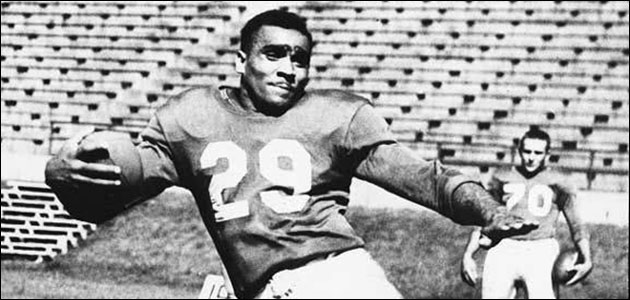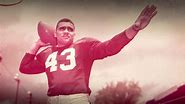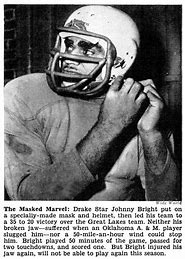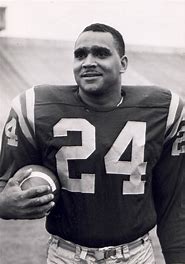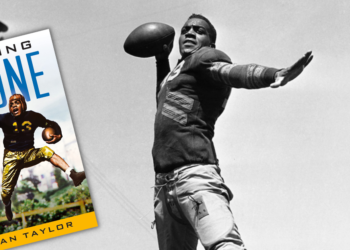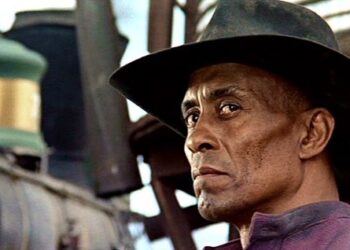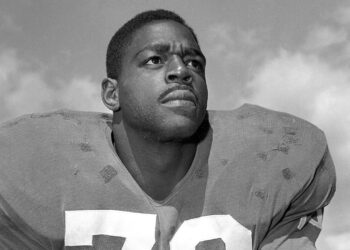By: Greg Rector
John Dee Bright was born in Fort Wayne, Indiana in 1930. He was a three-sport star at Fort Wayne Central High School in track and field, basketball, and football. In 1945 Central High would win the city football title led by Bright and helped the basketball team to reach the “Final Four” twice in the basketball-crazed Hoosier state. In 1947 Bright accepted a football scholarship to attend Michigan State University. Unhappy with the direction of the Spartans, Bright transferred to Drake University in Des Moines, Iowa.
At Drake, Bright would play both quarterback and halfback for the Bulldogs. As a sophomore, he ran and passed for 975 yards each that season leading Drake to a 6-2-1 record. In his junior season, he then set an NCAA record at the time for scrimmage yards rushing for 1,232 yards and passing for another 1,168 yards while once again the Bulldogs would have a 6-2-1 record.
The 1951 season was Bright’s senior year and he was a pre-season Heisman Trophy candidate. After winning their first five games the Drake Bulldogs star had rushed for 821 yards and led the nation both rushing and again in scrimmage yards with 1,349 total yards. Everything would change in that sixth game of the season as the Drake Bulldogs were traveling to Stillwater Oklahoma to face Oklahoma A&M (Oklahoma State University today)
Johnny Bright Incident
October 20th, 1951 is an UGLY day in college football history. The game between Drake and Oklahoma A&M was the first time that such a prominent African-American player as Johnny Bright had come to play in a state not overly friendly, to say the least towards African-American players. This is after all just 4 years after Jackie Robinson had broken baseball’s color barrier. Bright was playing so well that he was certainly going to be a finalist for the Heisman Trophy.
Within the first seven minutes of the game Oklahoma A&M’s defensive tackle, Wilbanks Smith hit Johnny Bright three times each time was more vicious, Banks was using his elbows to punish Bright. This was in an era before faceguards. The third hit broke Bright’s jaw badly. Despite the viciousness of the hits by Banks, Bright threw for a 61-yard TD pass before being forced out of the game due to his injury. Oklahoma A&M would defeat Drake 27-14.
It was pretty clear to many that Banks was racially motivated to come after Bright in such a vicious manner. There was a photographic sequence taken by Des Moines Register photographer Don Ultang clearly showed the hits by Smith were delivered well after a pass was thrown (Legitimate roughing the passer calls) and even well after Johnny Bright had handed off the ball. The other reason it was a racially motivated attack was confirmed by statements in both Oklahoma A&M \’s student newspaper and the Stillwater paper. One of the quotes was “Bright will not be around at the end of the game.”
No action was taken by either Oklahoma A&M or by the Missouri Valley Conference that both schools were in at the time. Drake University withdrew from the conference and would not return until 1956. Bradley University joined Drake in leaving as well in protest.
The “Johnny Bright Incident” did bring about rule changes by the NCAA regarding illegal blocking and mandating the use of more protective helmets with face guards.
Johnny Bright is the only football player to ever have his jersey retired at Drake University. He finished his career with 5,983 yards of total offense as a Bulldog. He was fifth in the Heisman Trophy voting for the 1951 season despite missing the final three games after Smith’s attacks.
Professional Football
The Philadelphia Eagles drafted Johnny Bright in 1952 but he never played a single down in the NFL. He was worried about how he would be treated.
“I would have been their (the Eagles’) first Negro player. There was a tremendous influx of Southern players into the NFL at that time, and I didn’t know what kind of treatment I could expect.”
Instead like many others in that era Johnny Bright came to Canada to play in the CFL. In his first three seasons, he played for the Calgary Stampeders. During his rookie season, he was a linebacker/fullback and rushed for 815 yards. He would be good for the Stampeders but in the middle of the 1954 season, he would be traded to rival Edmonton Eskimos. It was in Edmonton that Johnny Bright would live up to his surname The Eskimos’ first great run of Grey Cups coincided with Johnny Bright’s arrival. Three straight Grey Cups in 1954 1955 and 1956. The Eskimos were simply a powerhouse led by Bright and other stars like Jackie Parker, Normie Kwong, and another African-American legend in Rollie Miles. Johnny Bright would remain with the Eskimos until the 1964 season. When he retired Bright was the CFL’s all-time leading rusher with 10,909 yards in 13 seasons. Bright’s career 5.5 yards per carry puts him ahead of the great Jim Brown who was at 5.3 yards per carry, don’t forget Bright maintained that in a longer career than Brown’s. He was also the first black player to win the CFL’s Most Outstanding Player Award in 1959. My dad was a kid in those years and he loved retelling how he and his friends would sneak into old Clarke Stadium to watch those Eskimo teams.
The Community Leader
Johnny Bright was also a teacher beginning in 1957. He turned down NFL offers because at the time the money he made teaching and playing for the Eskimos was better than he could earn in the United States. During his teaching career at D.S. Mackenzie and Hillcrest Junior High Schools, he would become the principal at both schools. In addition to his junior high school work, he would also coach the Bonnie Doon High School Lancers in the 1960s and made them a perennial powerhouse. He was honored for his contributions to education and his community work in 2010 when the Johnny Bright School for kindergarten through Grade 9 (Junior High) opened. There’s also a sports park named in honor of Bright in Edmonton as well.
Legacy
Sadly Johnny Bright did not live to see the school or sports park named for him. December 14th,1983 Bright had a massive heart attack while awaiting elective knee surgery from injuries during his playing career. He was inducted into the Canadian Football Hall of Fame in 1970. His name was put into the Eskimos Ring of Honor in 1983 and in 2006 was the 19th ranked of the CFL’s all-time best 50 players. He also played in an incredible 197 straight games playing both offense and defense. In 2006 his alma mater Drake University named their football field in his honor as well. Mr. Bright was truly a great man who touched the lives of football fans certainly but more importantly the lives of all those students and the players he coached for all those years.


 NFL
NFL